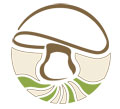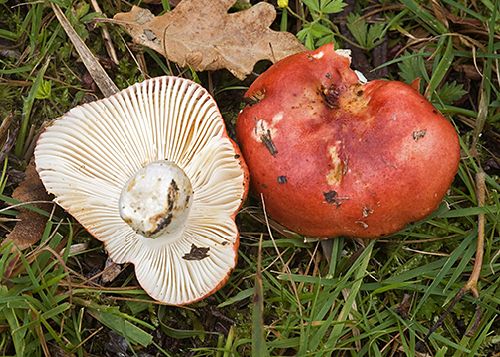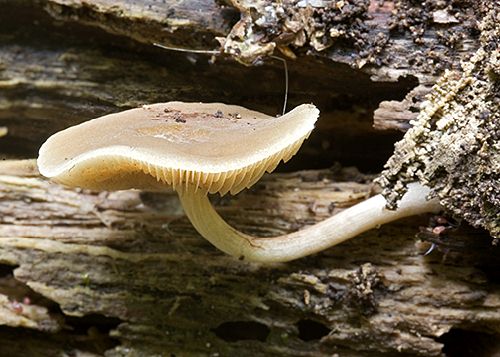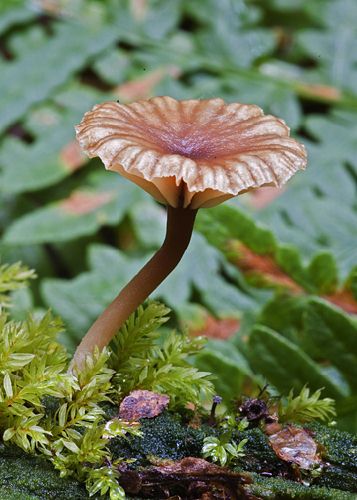Millyford Bridge & Wood Crates
Sat 13 Aug 2011
Field event ID HF1115
OS Grid areas: SU2607 SU2608 SU2708
Weather: Cloudy with sunny intervals
Report: (Eric Janke) Millyford Bridge is normally a very popular and productive site. On this occasion, it only managed to be one of the two! However the select band of forayers were rewarded with some interesting specimens and excellent photo opportunities. Find of the day should probably go to Joan's collection of Cortinarius armillatus, although the striking, shellfish-scented, Lactarius volemus and another, sadly unnamed Cort. (possibly triumphans - AL) gave it some competition. Identification in the field continues to be a challenge to some, with Eric's (somewhat) confident declarations as the the identities of Russulas ionochlora and leuteotacta turning out to be brunneoviolacea and melliolens once the spores were examined, a Cortinarius (unnamed) was dismissed as a "Brown Rollrim" and a soft brown Daedelopsis turned out to be Hapalopilus nidulans. Even back in the lab, it was not always plain sailing - there was discussion over what turned out to be Amanita porphyria (too light and with no signs of any veil sticking to the cap), an Omphalina which, despite its subglobose spores, was probably pyxidata (if only because the New Forest is not normally considered sub-Arctic!) and a tiny agaric, growing on wood which Paul discovered was actually an Entoloma... The total number of records, which amounted to 15 per forayer, reinforces the status of the site, particularly given the time of year and the absence of any paint-specialists!
Species list: Amanita citrina var. alba, Amanita excelsa var. spissa, Amanita fulva, Amanita porphyria, Amanita rubescens var. rubescens, Annulohypoxylon cohaerens, Bjerkandera adusta, Boletus badius, Bulgaria inquinans, Calocera cornea, Calocera pallidospathulata, Calocera viscosa, Cortinarius armillatus, Cortinarius mucifluoides, Dacrymyces stillatus, Daedaleopsis confragosa, Exidia thuretiana, Fuscoporia ferrea, Ganoderma australe, Gymnopus dryophilus, Gymnopus fusipes, Hapalopilus nidulans, Hydnum repandum, Hygrophoropsis aurantiaca, Hymenochaete rubiginosa, Hypholoma fasciculare var. fasciculare, Hypoxylon fragiforme, Lachnum virgineum, Lactarius azonites, Lactarius volemus, Leccinum cyaneobasileucum, Leccinum scabrum, Marasmiellus ramealis, Marasmius rotula, Mensularia radiata, Mycena pseudocorticola, Neobulgaria pura var. pura, Omphalina pyxidata, Panaeolus semiovatus var. semiovatus, Peniophora quercina, Phellinus igniarius, Piptoporus betulinus, Pleurotus ostreatus, Pluteus cervinus, Pluteus semibulbosus, Polyporus leptocephalus, Postia tephroleuca, Rhopographus filicinus, Russula anthracina, Russula atropurpurea, Russula brunneoviolacea, Russula claroflava, Russula cyanoxantha, Russula melliolens, Russula nigricans, Russula ochroleuca, Russula rosea, Russula velenovskyi, Russula vesca, Russula virescens, Schizopora paradoxa, Scleroderma areolatum, Scleroderma citrinum, Simocybe haustellaris, Simocybe sumptuosa, Stereum hirsutum, Stereum subtomentosum, Trametes gibbosa, Trametes versicolor, Tremella mesenterica, Tricholomopsis rutilans, Trochila ilicina, Tubaria dispersa, Xylaria carpophila, Xylaria hypoxylon, Xylaria polymorpha

.jpg)


.jpg)
.jpg)
